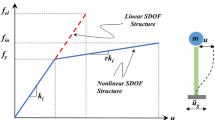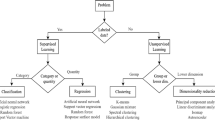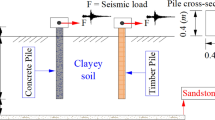Abstract
Displacement is a better indicator of building damage than force; therefore, performance-based seismic design methodologies aim at controlling damage through limiting lateral inelastic displacement of structures. This study aims at predicting the inelastic displacement demand of structures through utilizing artificial neural networks and Bayesian regularization algorithm. A large set of inelastic displacement ratios was computed using nonlinear time history analyses of single-degree-of-freedom oscillators subjected to ground motions recorded on soft soils. Four types of hysteretic models were utilized to cover a wide range of structures, namely flag-shaped, elastic-perfectly plastic, small-Takeda, and large-Takeda hysteretic models. The inelastic displacement ratios were correlated with displacement ductility and structure period normalized to ground motion record predominant period. The study offered insight on inelastic displacement ratios of structures built on soft soils, the effect of structure period, ground motion predominant period, ductility level, and hysteretic model. The inelastic displacement ratios exceeded one for periods less than the record predominant period, while for periods more than 1.5 the predominant period, it was almost equal to one. Furthermore, in the vicinity of the ground motion record predominant period, inelastic displacement demands are smaller than elastic displacement demand. Dispersion of inelastic displacement ratio increases as the inelastic displacement demand increases, while larger dispersion was evident for structures with period ranges between 1.5 and 2.0 times the ground motion predominant period. Finally, the study provided the necessary parameters needed for artificial neural network models to regenerate inelastic displacement ratio models needed in designing structures built on soft soils.















Similar content being viewed by others
References
Veletsos AS, Newmark NM (1960) Effect of inelastic behavior on the response of simple systems to earthquake motions. In: Proceedings of the 2nd World Conference on Earthquake Engineering, Vol. II, Tokyo, pp 895–912
Veletsos AS, Newmark NM (1964) Response spectra for single-degree-of-freedom elastic and inelastic systems. Rep. No. RTD-TDR-63-3096, Vol. III, Air Force Weapons Laboratory, Albuquerque, N.M
Rahnama M, Krawinkler H (1993) Effects of soft soil and hysteresis model on seismic demands. Rep. No. 108, John A. Blume Earthquake Engineering Center, Stanford Univ., Stanford, Calif
Miranda E (1991) ‘‘Seismic evaluation and upgrading of existing structures.’’ PhD thesis, University of California, Berkeley, Berkeley, Calif
Miranda E (1993) Evaluation of site-dependent inelastic seismic design spectra. J Struct Eng ASCE 119(5):1319–1338
Miranda E (1993) ‘Evaluation of seismic design criteria for highway bridges.’ Earthq Spectra 9(2):233–250
Miranda E (1999) ‘Approximate seismic lateral deformation demands in multistory buildings.’ J Struct Eng ASCE 125(4):417–425
Miranda E (2001) ‘Estimation of inelastic deformation demands of SDOF systems.’ J Struct Eng 127(9):1005–1012
Ruiz-García J, Miranda E (2004) Inelastic displacement ratios for design of structures on soft soils sites. J Struct Eng 130(12):2051–2061
Ruiz-García J, Miranda E (2006) Inelastic displacement ratios for evaluation of structures built of soft soil sites’. Earthq Eng Struct Dyn 35:679–694
Riddell R, García JE, Eugenio G (2002) Inelastic deformation response of SDOF systems subjected to earthquakes. Earthq Eng Struct Dyn 31:515–538
Chopra AK, Chintanapakdee C (2004) Inelastic deformation ratios for design and evaluation of structures: single-degree-of-freedom bilinear systems. J Struct Eng 130(9):1309–1319
Benazouz C, Moussa L, Ali Z (2012) Ductility and inelastic deformation demands of structures. Struct Eng Mech 42(4):631–644
Rahgozar N, Moghadam AS, Aziminejad A (2016) Inelastic displacement ratios of fully self-centering controlled rocking systems subjected to near-source pulse-like ground motions. Eng Struct 108:113–133
Chickh B, Laouami N, Mebarki A, Leblouba M, Mehani Y, Kibboua A, Hadid M, Benouar D (2017) Seismic structural demands and inelastic deformation ratios: sensitivity analysis and simplified models. Earthq Struct 13(1):59–66
Guerrini G, Graziotti F, Penna A, Magenes G (2017) Improved evaluation of inelastic displacement demands for short-period masonry structures. Earthq Eng Struct Dyn 46(9):1411–1430
Stafford PJ, Sullivan TJ, Pennucci D (2019) Empirical correlation between inelastic and elastic spectral displacement demands. Earthq Spectra 32(3):1419–1448
Lestuzzi P, Diana L (2019) Accuracy assessment of nonlinear seismic displacement demand predicted by simplified methods for the plateau range of design response spectra. Adv Civ Eng, Article ID 1396019
Yaghmaei-Sabegh S, Daneshgari S, Neekmanesh S (2020) Inelastic displacement ratio for high damping SDOF systems built on soft soil sites. Soil Dyn Earthq Eng, vol 135, Article ID 106203
Kisi Ö, Çobaner M (2009) Modeling river stage-discharge relationships using different neural network computing techniques. Clean: Soil, Air, Water 37(2):160–169. https://doi.org/10.1002/clen.200800010
Ostad-Ali-Askari K, Shayannejad M, Kharazi H (2017) Artificial neural network for modeling nitrate pollution of groundwater in marginal area of zayandeh-rood river, Isfahan, Iran. KSCE J Civ Eng Korean Soc Civ Eng 21(1):134–140. https://doi.org/10.1007/s12205-016-0572-8
Derakhshannia M, Dalvand S, Asakereh B, Ostad-Ali-Askari K (2020) Corrosion and deposition in Karoon River, Iran, Based on hydrometric stations. Int J Hydrol Sci Technol. 10(4):334–345. https://doi.org/10.1504/IJHST.2020.108264
Ostad-Ali-Askar K, Su R, Liu L (2018) water resources and climate change. J Water Clim Change. 9(2):239. https://doi.org/10.2166/wcc.2018.999
Xie Y, Sichani M, Padgett J, DesRoches R (2020) The promise of implementing machine learning in earthquake engineering: a state-of-the-art review. Earthq Spectra 36(4):1–33
Yucel M, Bekdaş G, Nigdeli SM, Sevgen S (2019) Estimation of optimum tuned mass damper parameters via machine learning. J Build Eng 26:100847
Etedali S, Bijaem ZK, Mollayi N, Babaiyan V (2021) Artificial intelligence-based prediction models for optimal design of tuned mass dampers in damped structures subjected to different excitations. Int J Struct Stab Dyn, p 2150120
Yucel M, Öncü-Davas S, Nigdeli SM, Bekdas G, Sevgen S (2018) Estimating of analysis results for structures with linear base isolation systems using artificial neural network model. Int J Control Syst Robot, 3
Bojórquez E, Bojórquez J, Ruiz S, Reyes-Salazar A (2012) Prediction of inelastic response spectra using artificial neural networks. Math Prob Eng 2012:15
Ostad-Ali-Askari K, Shayannejad M (2021) Computation of subsurface drain spacing in the unsteady conditions using Artificial Neural Networks (ANN). Appl Water Sci 11:21. https://doi.org/10.1007/s13201-020-01356-3
Author information
Authors and Affiliations
Corresponding author
Ethics declarations
Conflict of interest
The authors declare that they have no conflict of interest.
Rights and permissions
About this article
Cite this article
Dwairi, H.M., Tarawneh, A.N. Artificial neural networks prediction of inelastic displacement demands for structures built on soft soils. Innov. Infrastruct. Solut. 7, 4 (2022). https://doi.org/10.1007/s41062-021-00604-y
Received:
Accepted:
Published:
DOI: https://doi.org/10.1007/s41062-021-00604-y




